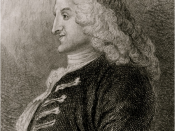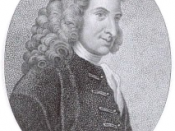English literature reached its peak during three distinct periods: 1740-1770, 1840-1890, and 1905-1930. The 1740-1770 group of novelists is comprised of Samuel Richardson, Henry Fielding, Laurence Sterne, and Tobias Smollett. Each of these writers was especially distinct and unique. Having a tremendous reputation during his time, Richardson had a "great deal of influence on the development of fiction" (Priestly) by writing a book of letters. "A very different type of man," (Priestly) Fielding detested all of Richardson's works, writing instead about the ills of society. Sterne's reputation has a different account. His unique style consisted of cutting out all the needless information about the characters in his novels and focusing only on the essential traits. Smollett, on the other hand, concentrated on charming the reader with humor and sentiment. The 1840-1890 group starts off with Charles Dickens, a master of fiction. Shortly after his time, English prose fiction started to expand its horizons, talking about distant lands instead of England.
The 1905-1930 group boasts three main writers: H.G. Wells, Arnold Bennett, and John Galsworthy. These writers of the 20th century, unlike their predecessors, published their works in parts. Before this time, novels were printed in volumes and cost a fortune. This new improvement allowed even the common people to enjoy books. Because of its great writers and new ideas, English literature reached its zenith during the 1740-1770, 1840-1890, and 1905-1930.


